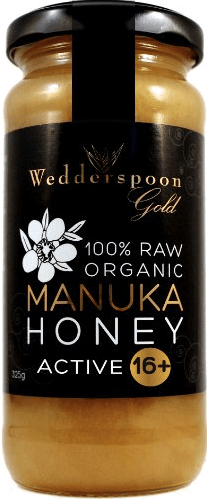
Miracles do happen, my friend.
And every week or so, I apply a little miracle to my skin: manuka honey.
Manuka honey is produced in New Zealand by bees that pollinate the native manuka bush. It is used in both traditional and modern medicine (yep!) for its natural antibacterial properties. In addition to containing hydrogen peroxide, manuka honey is high in the antibacterial methylglyoxal (MG). MG is found in most types of honey in small quantities. However, manuka honey contains up to 100 times more MG than normal honey.
Here are a few recognizable bacteria and viruses that MG has been shown to kill when tested in a lab environment:
- Helicobacter pylori (i.e. H. pylori): The bacterium known to cause many stomach ulcers and “leaky gut” syndrome
- Staphylococcus aureus (i.e. staph infection) and MRSA: These “super-bugs” are known for their resistance to many antibiotics
- Escherichia coli (i.e. E. Coli): Known to cause serious food poisoning
- Streptococcus pyogenes (i.e. strep throat): The bacterium known to cause strep throat
Pretty amazing, huh?
But manuka honey belongs on your bathroom shelf as much as it does in a medical clinic or hospital.
Because it also keeps skin clear, youthful, and hydrated.
Skin-clearing.
Manuka honey works wonders for blemished skin because of its aforementioned natural antibacterial properties. It is also a potent anti-inflammatory, so soothes inflamed skin while healing blemishes. It also helps balance the skin’s pH and contains amino acids which slough away dead skin cells, helping to keep pores clear. In other words: this sticky-sweet substance is your problem skin’s best friend (or worst enemy, depending on which way you want to look at it).
Anti-aging.
MG has been shown to increase collagen cross-linking, promoting the structural growth of collagen in skin cells. And since amino acids are the building blacks of collagen, they also protect collagen. Healthy collagen means healthy, firm, youthful-looking skin.
Helps skin retain moisture.
Manuka honey is a natural humectant, drawing moisture into the skin. This hydration helps to further enhance the skin’s elasticity and cell regeneration, as well as promote healing.
 Decoding manuka honey labels.
Decoding manuka honey labels.
The bioactivity or strength, so to speak, of manuka honey varies and is indicated by a number ranging between 5 and 25.
- UMF 5-9: low activity levels
- UMF 10-15: moderate activity levels
- UMF 16+: high activity levels
You may have noticed that I’ve been linking you to an organic, raw 16+ manuka honey that comes in a glass jar. This is the honey I own and it checks off all of the boxes (you know how I feel about plastic). Yes, it looks pricey and it is. But this 11.5 oz jar will last a VERY long time, particularly if you are using it for topical use only. Plus, manuka honey has a practically infinite shelf life.
How I use manuka honey.
As I mentioned at the very beginning of this post, I use manuka honey weekly as a face mask. After washing and gently exfoliating my face with baking soda, I pat it dry and apply a very thin (probably about a teaspoon total) layer of manuka honey. I let it sit at least 30 minutes (but sometimes up to a few hours!), then wash it off with warm water and apply my DIY face oil for oily and acne-prone skin.

No comments:
Post a Comment